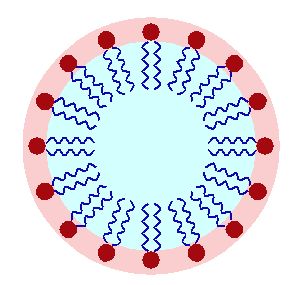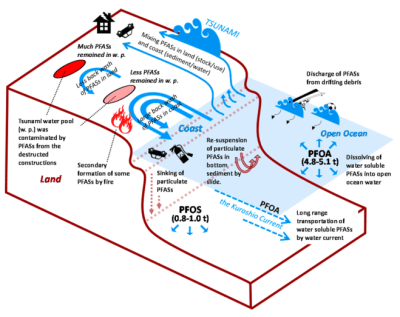

PFAS: The Organofluorines Your Biochemist Warned You About
source link: https://hackaday.com/2021/11/22/pfas-the-organofluorines-your-biochemist-warned-you-about/
Go to the source link to view the article. You can view the picture content, updated content and better typesetting reading experience. If the link is broken, please click the button below to view the snapshot at that time.
PFAS: The Organofluorines Your Biochemist Warned You About
Sometimes it begins to feel like a tradition that a certain substance or group of substances become highly popular due to certain highly desirable chemical or physical properties, only for these chemicals then to go on to turn out to form a hazard to the biosphere, human life, or both. In the case of per- and polyfluoroalkyl substances (PFAS) it’s no different. Upon the discovery that a subgroup of these – the fluorosurfactants – have the ability to reduce water surface tension significantly more than other surfactants, they began to be used everywhere.
Today, fluorosurfactants are being used in everything from stain repellents to paint, make-up, and foam used by firefighters. In a recent study of 231 cosmetic products bought in the US and Canada (Whitehead et al., 2021), it was found that all of them contained PFAS, even when not listed on the packaging. The problematic part here is that PFASs are very stable, do not decay after disposal, and bioaccumulate in the body where they may have endocrine-disrupting effects.
Some areas have now at least partially banned PFAS, but the evidence for this is so far mixed. Let’s review what we do know at this point, and which alternatives we have to continuing to use these substances.
Love It or Hate It
 Schematic diagram of a micelle of oil in aqueous suspension, such as might occur in an emulsion of oil in water. In this example the surfactant molecules’ oil-soluble tails project into the oil, while the water-soluble ends remain in contact with the water phase. (Credit: Stephen Gilbert)
Schematic diagram of a micelle of oil in aqueous suspension, such as might occur in an emulsion of oil in water. In this example the surfactant molecules’ oil-soluble tails project into the oil, while the water-soluble ends remain in contact with the water phase. (Credit: Stephen Gilbert)Surfactants (surface-active agents) find uses in wetting, dispersing, emulsifying, foaming as well as anti-foaming agents. This versatility has resulted in them making it into an astounding number of products, ranging from personal care items including shampoos, conditioners, cosmetics, and toothpaste, to ski waxes, anti-fogging treatments, inks, adhesives, paints, soaps, emulsions, fabric softeners, and detergents, to firefighting foam, herbicides and insecticides.
The basic principle that makes surfactants work are a head that’s hydrophilic and one or more tails that are hydrophobic. This enables the macro properties like foam control or emulsification that form such an essential feature of many every day products.
Most surfactants’ tails are rather similar, taking the form of a hydrocarbon chain. PFAS used as surfactants have a fluorocarbon chain instead, which offers better properties than hydrocarbon-based surfactants, in addition to their better stability in harsher environments. This stability also explains why discarded PFAS don’t degrade, but instead collect in surface and ground water, as well as in the soil and in the bodies of animals – including humans.
PFAS Everywhere Around You
 Schematic illustration of perfluoroalkyl substance emissions
Schematic illustration of perfluoroalkyl substance emissionsfrom land to ocean following the earthquake EQ 3.11. (Credit: Yamazaki et al., 2015)
When the massive earthquake and subsequent tsunami near Fukushima, Japan, hit, it caused both massive destruction and the release of large amounts of chemicals into the environment. PFAS were among these chemicals, and these were tracked in a 2015 study (Yamazaki et al.). This event could be regarded as a time-accelerated version of the usual spread of PFAS.
Tracked were primarily PFOS (perfluorooctonatesulfate, C8HF17O3S ) and PFOA (perfluorooctanoate, C8HF15O2), which are used widely in carpeting, floor waxes, and sealants. These and other PFAS were measured in 2010 and again in 2011 in the ocean waters.
This study shows how rainwater carries PFAS from land to surface waters, with ocean currents like the Kuroshio Extension Current apparently transporting PFOA and PFHxA, but not PFOS and PFHxS based on measured levels. This indicates that different types of PFAS do not diffuse equally in the oceans, and hint that the same might be true elsewhere. Yamazaki et al. speculate that this might be due to the different water solubility of the PFAS types.
In a less disastrous setting, PFAS find their way into surface waters via sewer systems, landfills and rainwater, with some amount being ingested by animals and biomagnification ensuring that the total amount of PFAS in each subsequent predatory creature increases. As PFAS like PFOS tend to accumulate in the liver (Jones et al, 2009), and bind to serum proteins, the likelihood is high that they will find their way up in the food chain.
The Human Impact
PFAS, being chemically inert, was assumed to be biochemically safe. The exact impact on human health is still being assessed today. One of the biggest studies in that regard was the C8 Health Project, which saw 69,030 participants enrolled. These participants lived in an area with a large contamination with PFOA (also referred to as ‘C8’ here). The findings were summarized by Steenland et al., 2020.
They found a supportive association with kidney and testicular cancer exists, though there is no evidence of other site-specific cancers. A positive association with cholesterol is consistent, and there’s evidence for ulcerative colitis, but not other auto-immune diseases. As noted by Steenland et al., the epidemiological evidence remains limited, even in such a large meta-study.
Solid evidence exists in the effect of PFOA and PFDA (perfluorodecanoic acid, C10HF19O2) downregulating activity in the liver, as described by Cheng et al., 2008, in mouse livers. Both PFASs are agonists for the PPAR-α receptor, the effect of which is the downregulation of mRNA expression for polypeptides that are required for the uptake of bile acid (BA). There are a number of negative associations with increased BA levels, which was found for PFDA but not PFOA, although both are clearly affecting the liver.
Whether or not male fertility is affected still needs more research (Tarapore et al., 2020), while the question of food safety has been studied by the European Food Safety Agency, which has set maximum allowed daily intake levels for PFAS based on their findings. They note studies (e.g. Macon et al., 2011; Tucket et al., 2015; White et al., 2011) that indicate clear negative impacts of PFOA on the development of the mammary glands of animals exposed in utero, during lactation, etc.
Also noted are the observed effects on the body’s immune system. What makes it hard to establish definite causality, however, is that the mechanism behind various adverse effects is still unclear. This makes it hard to impossible to make any definite statements about how bad each type of PFAS is, leading to a cautionary approach that also ties into the search for alternatives.
Alternatives
The use of PFOS has been reduced significantly already. For example, 3M has replaced PFOS with the shorter chained perfluorobutanesulfonic acid (PFBS, C4HF9O3S) in Scotchgard. Where PFOS has a half-life of 5.4 years in humans, PFBS sticks around for roughly a month. Whether is shorter half-life in the body is sufficient to allay any potential health effects is still unknown, and the European Union has added PFBS to the candidate list of Substances of Very High Concern (SVHC) as a result.
The impact of PFAS continues to be studied by the EPA, as well by the Canadian government, with no immediate timeline for action. A program to investigate the use of shorter chain PFAS as alternatives has been submitted for review.
While there has been some evidence suggesting that longer-chain PFAS are involved in negative health effects, both for humans and animals in general, we lack an understanding of the mechanisms behind these effects. The amount of PFAS in the environment is unlikely to decrease soon, and it’s too early to say whether shorter-chain PFAS are an actual fix here (Birnbaum et al., 2015). This leaves us in an uncomfortable limbo.
Yes, No, Kinda
As unsatisfactory it is to be left without a clear and absolute conclusion on whether PFASs in general are good or bad, the reality remains that this is a complex topic, involving many chemicals and countless, complex interactions. While some studies have shown clear evidence that some types of PFAS like PFOS and PFOA are harmful, many of the effects are perhaps not strong enough to be noticed against the background of everything else that our environment subjects our bodies to.
Perhaps the obvious course is to apply the precautionary principle, and use alternatives to PFAS where we can, and PFASs that degrade faster when we can’t, even if we cannot be certain that the alternative is perhaps not worse than the original. This, as noted in the introduction, remains the eternal problem with assessing the safety of chemicals in the environment and in our bodies: we can only do our best using the knowledge and technology we have today.
[Banner image: “Water droplets on hydrophobic feather!” by The Manic Macrographer, CC BY 2.0. (Feathers do it with nanostructures instead of fluorines.)]
[Thumbnail image: “A water droplet on a coated surface” by Brocken Inaglory, CC BY-SA 3.0]
Recommend
About Joyk
Aggregate valuable and interesting links.
Joyk means Joy of geeK